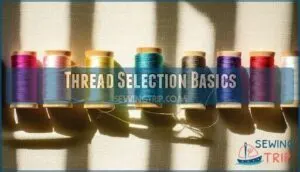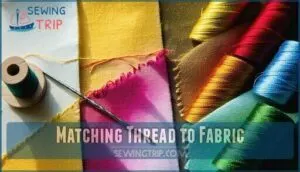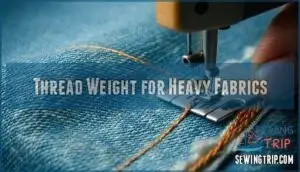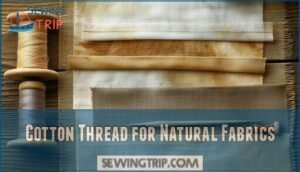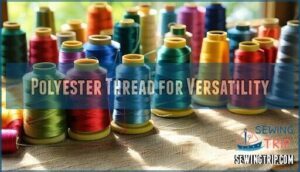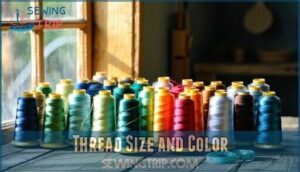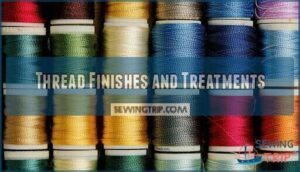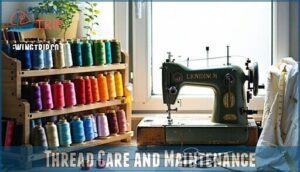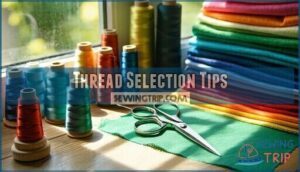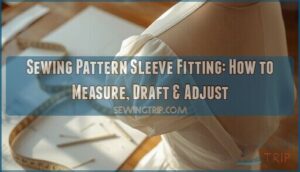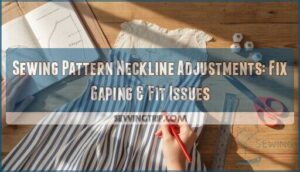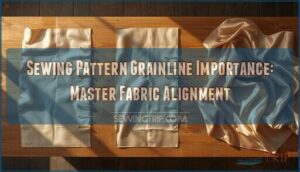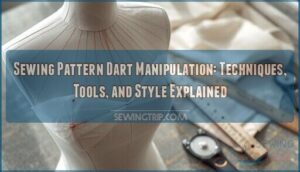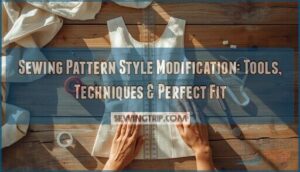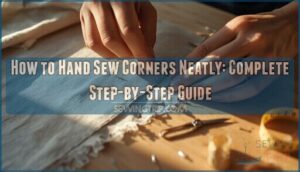This site is supported by our readers. We may earn a commission, at no cost to you, if you purchase through links.
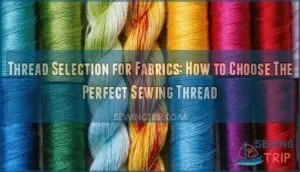
For breathable fabrics like cotton, stick with natural cotton thread.
Polyester thread, on the other hand, is your go-to for versatility and strength, especially with stretchy or synthetic fabrics.
Match the thread size to fabric weight: fine threads (60-80) for delicate fabrics, all-purpose (40-50) for medium weight, and heavy-duty (30-40) for thicker materials.
Color matters too—match or slightly darker for seams, but let contrast threads shine in decorative stitching.
Thread choice can elevate your project, making every stitch count, and it’s about making every stitch count.
Table Of Contents
Key Takeaways
- Match your thread fiber to your fabric type—use cotton thread for natural fabrics like cotton and linen, polyester for synthetics and stretchy materials, and nylon for heavy-duty projects that need extra strength.
- Choose thread weight based on your fabric’s thickness—fine threads (60-80 weight) work best for delicate fabrics, all-purpose threads (40-50 weight) suit medium-weight materials, and heavy-duty threads (30-40 weight) handle thick fabrics like denim.
- Pick thread colors strategically—match or go slightly darker for invisible seams, but don’t hesitate to use contrasting colors for decorative stitching that’s meant to stand out.
- Invest in quality thread and proper storage—cheap thread breaks easily and causes frustration, while well-stored thread maintains its strength and color, preventing project delays and ensuring professional results.
Thread Selection Basics
When choosing thread for your fabric, start by considering its fiber type, weight, and compatibility with your material.
Understanding these basics guarantees strong, smooth seams and enhances your sewing project’s durability.
Natural Fiber Threads
Natural fiber threads, like cotton, silk, and wool, are ideal for breathable fabrics.
Cotton, silk, and wool threads bring natural breathability and elegance, perfect for comfort, durability, and sustainable sewing projects.
Cotton thread is a go-to for natural fibers, as it blends seamlessly with materials like linen and rayon.
Silk thread adds a luxurious, smooth finish, perfect for delicate projects.
Wool threads, with their warmth and elasticity, suit heavier fabrics.
These eco-friendly options offer excellent moisture absorption, making them ideal for comfortable garments, sustainable designs, and functional, long-lasting sewing projects.
Synthetic Fiber Threads
Synthetic fiber threads are reliable workhorses for strength and versatility in sewing.
They’re resistant to shrinking, fraying, and heat, making them perfect for tough or stretchy materials.
- Polyester threads resist UV rays and abrasions, ideal for outdoor fabrics.
- Nylon threads handle heavy stress, great for straps and upholstery.
- Acrylic threads add vibrancy and softness.
- Elastic threads provide stretch for activewear.
- Synthetic threads thrive in extreme cleaning or temperature conditions.
Blended Fiber Threads
Blended fiber threads bring durability and flexibility to your sewing projects.
Combining natural and synthetic fibers, like cotton-polyester blends, they balance softness with strength—perfect for multi-purpose use.
The fiber blend benefits include improved stretch, reduced shrinkage, and better thread performance under various conditions.
Consider blend composition ratios for compatibility with your fabric type.
These threads cost less than pure natural fibers but offer excellent versatility, making them ideal for diverse fabric thread types.
Choosing Thread Weight
Choosing the right thread weight guarantees your stitches hold up while blending seamlessly with your fabric.
The perfect thread weight ensures strong, flawless stitches that beautifully blend with your fabric for polished, durable results.
You’ll need to match the thread’s thickness to the fabric’s weight for smooth, durable results.
Matching Thread to Fabric
Matching sewing threads to fabric types is like pairing shoes with an outfit—it has to make sense. Fiber compatibility is the starting point: choose cotton thread for natural fabrics and polyester thread for synthetics.
For proper stitch appearance and project longevity, consider thread weight and fabric compatibility. Lighter threads suit delicate fabrics, while medium threads fit most daily projects.
Don’t skip tension adjustments—it impacts stitches and prevents puckering. Finally, align your thread and needle size for smooth, frustration-free sewing.
Thread Weight for Heavy Fabrics
Tackling heavy fabrics like denim, upholstery, canvas, or leather requires stronger thread choices to guarantee proper seam strength.
Opt for heavy-duty threads, such as Denim Thread or Upholstery Thread, typically labeled at 30–40 weight. These thicker threads match the fabric weight, preventing breakage and distortion under strain.
Pair with large needles and adjust machine tension for smooth stitching. Remember, fabric thread weights should complement the material’s thickness.
A well-matched thread enhances durability, keeping your projects sturdy and polished, no matter how tough the fabric.
Thread Weight for Delicate Fabrics
Delicate fabrics like silk require thoughtful thread selection to avoid stress on the material.
Opt for lighter thread weights (60-100) to complement fine textures.
Adjust bobbin tension and choose the right needle size—smaller needles prevent damage.
Use shorter stitch lengths for an elegant, smooth finish, and test on scraps to prevent puckering.
Balancing thread weight and thickness guarantees even stitching without strain.
Always match your silk thread to fabric properties, as careful planning guarantees beautiful, long-lasting results.
Fine details matter most with delicate fabrics!
Thread Fiber Content
Choosing the right thread fiber is essential for a fabric-friendly project. Whether it’s natural cotton or durable polyester, each type has unique strengths that match specific needs.
Cotton Thread for Natural Fabrics
When working with natural fibers, cotton thread is your go-to for impeccable results.
Whether it’s lightweight linen, durable hemp, or supple bamboo, cotton thread provides the perfect balance of strength and flexibility.
Its compatibility with natural fabrics means fewer snags and smoother seams.
Stick with this classic choice for consistent stitching, especially in eco-friendly or natural blends.
Matching the thread to your fabric type guarantees durability and seamless finishes every time.
Polyester Thread for Versatility
Polyester thread stands out for its durability and versatility, making it a reliable choice for various sewing projects.
Its UV resistance guarantees outdoor fabrics last longer, while its blending options mean smooth integration with both polyester blends and natural fabrics.
This all-purpose polyester thread holds color brilliantly, resists breakage, and adapts to different project applications, from invisible hems to bold topstitching.
Plus, its cost-effectiveness makes it a favorite for budget-conscious creators without compromising quality.
For flawless fabric compatibility, it’s a smart choice in your thread selection toolkit.
Nylon Thread for Heavy Fabrics
When sewing heavy fabrics, nylon thread brings unmatched fabric thread strength and thread durability.
Perfect for heavy-duty applications like upholstery, outdoor gear, and tough denim, it resists wear and handles stress effortlessly.
Stretch fabrics? Nylon shines by adding flexibility.
Adjust your tension settings properly—it’s all about balancing thread strength with fabric needs.
For outdoor gear, nylon’s UV resistance guarantees longevity, even in harsh conditions.
Bonded nylon, with its smooth finish and reduced friction, is an ideal choice for rugged heavy-duty threads that last.
Thread Size and Color
Choosing the right thread size and color is essential to guarantee your sewing project looks clean and professional.
By matching thread thickness to your fabric and selecting a complementary or blending color, you’ll achieve strong, seamless stitches that enhance your design.
Selecting Thread Size for Fabric Type
Choosing the right thread size depends on fabric density, needle size, and stitch length.
For smooth sewing and project durability, match thread weight to fabric type:
- Lightweight fabrics (like silk): Use fine threads (60-80) and small needles for delicate stitches.
- Medium-weight fabrics (like cotton): All-purpose threads (40-50) guarantee fabric compatibility.
- Heavy fabrics (like denim): Use sturdy threads (30-40), adjust thread tension, and confirm needle size matches for strong seams.
Choosing Thread Color for Solid Fabrics
When picking thread colors for solid fabrics, undertones matter. Go for a thread shade slightly darker than your fabric—it blends seamlessly as stitching reflects light.
A monochromatic scheme works wonders: match your thread to the fabric’s shadows for subtle elegance.
For bold styles, use contrast stitching to stand out.
Want perfect thread color matching? Test blending techniques on scraps to check how the color matching appears under different lighting.
Choosing Thread Color for Patterned Fabrics
When working with patterned fabrics, thread color matching shifts from simple to strategic. Start by identifying the dominant colors in your design and consider these for your thread choice. For a subtle touch, use blending threads that match the background or opt for a monochromatic scheme.
On the other hand, accent stitching can add interest and depth.
- Look at the print scale; smaller patterns benefit from neutral threads for seamless results.
- Go bold with pattern contrast if you want stitches to pop for a decorative effect.
Choose darker thread shades to minimize visibility or lighter hues to highlight texture.
Thread Types and Uses
Choosing the right thread type is essential for ensuring strong seams and a polished finish.
Whether you’re sewing everyday projects, decorative accents, or heavy-duty items, understanding thread uses helps match the right thread to your fabric and purpose.
General Purpose Threads
A true workhorse in your sewing kit, general purpose threads suit most projects seamlessly.
Made from 100% polyester, they excel in thread composition, offering strength and versatility.
Their smooth texture enhances stitch appearance, while tension adjustments are minimal for consistent results.
With excellent fabric compatibility, they handle silk to denim effortlessly.
For reliable thread longevity and fewer common issues, this handy thread makes thread selection simpler, adapting well to various fabric types and thread weight.
You can find a wide variety available online.
Specialty Threads for Decorative Purposes
Sometimes, sewing calls for a little extra flair, and specialty threads are perfect for those moments.
Decorative threads, like metallic threads, add shimmer and sophistication, making them ideal for holiday crafts or statement pieces. Glow-in-dark threads create playful, glowing accents that pop in dim light, while silk threads bring a subtle elegance to heirloom projects or brocade fabrics.
For a variety of options, consider purchasing metallic thread online.
- Use metallic threads to elevate festive table decor or gift wraps.
- Glow-in-dark threads make kids’ costumes magical and fun.
- Silk threads pair beautifully with luxurious gowns or upholstery, blending texture and color seamlessly.
Threads for Heavy-Duty Projects
When tackling tough materials, heavy-duty threads are your best ally.
Upholstery threads, nylon thread, and canvas threads deliver strength for projects like furniture or industrial applications.
For leather sewing, nylon adds flexibility, while polyester excels in outdoor use.
Canvas stitching and denim threads work well for rugged, everyday items.
Cotton threads suit denim durability but skip them for weather-exposed projects.
You can find a wide selection of threads for upholstery online.
For ultimate performance, consider threads for heavy-duty projects like PTFE for unbeatable strength and lifetime reliability.
Thread Finishes and Treatments
Thread finishes and treatments enhance a thread’s performance, ensuring it matches your project’s needs.
From mercerized cotton for extra strength to bonded finishes for durability, these treatments can make a big difference in stitch quality and fabric compatibility.
Mercerized Cotton Thread
Mercerized cotton thread stands out for its smooth finish and durability, thanks to the mercerization process.
This treatment enhances luster retention, strength comparison, and dye uptake, making it perfect for detail-oriented sewing. Whether you’re crafting heirlooms or sewing everyday items, it’s a reliable go-to.
- Best applications: quilting, embroidery, and fine sewing.
- Increased strength: outlasts regular cotton thread.
- Enhanced fabric compatibility: works beautifully on natural textiles.
Effective thread selection starts with understanding its versatility.
Gassed Thread for Smooth Finish
When you want stitches as smooth as a calm lake, gassed thread is the go-to option.
This thread goes through a unique gassing process where surface fuzz is burned off with a quick flame, leaving you with a silky finish that glides effortlessly through fabric.
It’s more than just fancy polishing—it enhances thread quality and guarantees a high-quality sewing experience.
Here’s how gassed thread works for you:
- Reduces breakage during high-speed sewing, keeping the process frustration-free.
- Smooths the surface, preventing snags in delicate fabrics.
- Delivers crisp, professional-looking stitches for a polished appearance.
- Consistent thread finish makes decorative stitching easier and cleaner.
Gassed thread truly perfects your thread selection for a flawless finish.
Bonded Thread for Durability
When heavy-duty projects call for high-quality strength, bonded thread stands out.
Thanks to its bonding process, it resists abrasion and stays intact under tough use.
Ideal for industrial applications, bonded thread also minimizes UV degradation, ensuring durability outdoors.
Whether you’re sewing sails or upholstery, it’s a go-to for thread durability.
Compare key properties below:
| Feature | Bonded Nylon | Bonded Polyester |
|---|---|---|
| Strength Testing | High | Moderate |
| Abrasion Resistance | Excellent | Great |
| UV Degradation | Moderate Resistance | High Resistance |
| Industrial Applications | Frequent Usage | Diverse Uses |
| Heavy-Duty Threads | Yes | Yes |
Thread Care and Maintenance
Taking care of your thread keeps your sewing projects smooth and frustration-free.
By storing it properly and handling damaged thread the right way, you can prevent breakage and extend its lifespan.
Storing Thread Properly
Your thread’s condition relies heavily on proper storage—think of it like preserving a timeless piece of art.
A little care goes a long way to maintaining durability and color vibrance.
Here are top tips for effective thread storage:
- Control humidity with airtight thread boxes to prevent moisture damage.
- Avoid sunlight exposure, as it can fade vibrant colors over time.
- Keep spools in a horizontal orientation or on foam-padded holders to prevent tangling.
- Use an organized system like color-coded drawers or clear containers for easy access.
Thread care is simple but essential.
Proper thread organization and maintenance guarantee spools remain strong and ready for use.
Protect your investment, and your sewing will always run smoothly!
Handling Old or Damaged Thread
Old thread doesn’t last forever, but proper thread care and maintenance can extend its lifespan.
When handling old or damaged thread, look for signs like brittleness, fading, tangling, or fiber decay.
To restore thread, freeze brittle spools overnight or store them in cooler, darker places to prevent further degradation.
For tangled or snarled threads, thread nets work wonders.
If thread condition worsens beyond repair, consider safe disposal or repurposing it for non-sewing crafts.
Regular checks prevent thread restoration hassles and guarantee reliable use in future projects.
Preventing Thread Breakage
Preventing thread breakage is all about balance—think of it like tuning a musical instrument. A few tweaks can make your sewing hum along perfectly.
Start by ensuring your needle matches the thread size and fabric; this boosts thread strength and prevents snapping. Keep bobbins clean and avoid overwinding them, as tight bobbins can strain thread tension.
Test tension settings on scrap fabric to find the sweet spot. Finally, maintain a steady sewing speed that suits your thread’s condition.
- Use high-quality thread for better durability.
- Clean your machine regularly to prevent buildup.
- Adjust thread tension for smooth stitching.
- Store threads properly to maintain their strength.
Maintaining your sewing machine and threads is crucial for preventing thread breakage and ensuring a smooth sewing experience, which is all about finding the right thread strength and sewing speed.
Thread Selection Tips
When choosing thread, focus on matching its weight and material to your fabric to guarantee strong, smooth seams.
A well-chosen thread will complement your fabric’s properties, improving durability and appearance.
Considering Fabric Type and Thread Weight
In selecting thread, always consider fabric type and thread weight together.
Assess your fabric’s density and stretch factor—this impacts stitch appearance and project durability.
Match lightweight fabrics with fine threads and heavyweight materials with sturdier options.
For example, use a 30-40 weight thread for heavy denim.
Don’t forget tension adjustment; improper settings can distort stitches.
Carefully aligning thread weight makes for smooth, strong results.
Choosing The Right Thread Color and Finish
Matching thread color and finish to your fabric is like choosing the right spices for a dish—get it wrong, and it shows.
To make your stitches shine, follow these steps:
- Color Matching: For solid fabrics, pick a slightly darker shade—it blends better. For prints, match the dominant color tone.
- Finish Types: Mercerized cotton adds sheen, strength, and color vibrancy. It’s perfect for polished seams.
- Blending Techniques: Natural lighting helps assess thread color options accurately. Avoid mismatched hues indoors only.
Explore finishes like decorative threads for texture and appeal!
Frequently Asked Questions (FAQs)
How do I choose the best sewing thread?
Choosing the best sewing thread feels like finding the perfect puzzle piece—match thread material to fabric type, guarantee weight complements fabric thickness, and test tension on scraps.
This guarantees smooth stitches and lasting durability.
How do I choose the right thread for my fabric?
Pick a thread matching your fabric type and weight.
Use cotton threads for natural materials, polyester for synthetics, or nylon for strength.
Test on scraps to verify tension, compatibility, and smooth stitching results.
Which fabric thread is best for sewing?
Imagine a puzzle—each fabric is a unique piece, and thread is the glue holding it together.
Use cotton for natural fabrics, polyester for synthetics, and nylon for heavy-duty tasks.
Match strength, weight, and stretch wisely.
What are fabric threads?
Fabric threads are the thin strands you use to stitch materials together.
They’re made from cotton, polyester, silk, or nylon fibers, each offering different strengths, stretch, and durability for your sewing projects.
What are the different types of fabric threads?
Over 80% of sewing project failures stem from wrong thread choices.
You’ll find natural threads like cotton and silk, synthetic options including polyester and nylon, plus specialty varieties for embroidery and heavy-duty applications, which can be crucial for the success of a project, making specialty threads important.
How do I choose a thread for sewing a silk fabric?
Use silk thread for the best match, or choose high-quality cotton thread as an alternative.
Select a thread color slightly darker than your silk fabric, and test tension on scraps first.
What thread to use for what fabric?
Match your thread to fabric type: cotton thread for cotton fabrics, polyester for synthetics, silk thread for silk.
Consider weight too—fine threads for delicate materials, heavy-duty for thick fabrics like denim.
Which is thicker, 40 wt or 50 wt thread?
Think of thread weight like wire gauge – the numbers work backwards.
40 weight thread is actually thicker than 50 weight.
Lower numbers mean thicker thread, so you’ll get more substantial stitches with 40wt.
How do I choose the right thread for sewing?
Your thread choice depends on fabric type and weight.
Cotton thread works best with natural fabrics, while polyester suits synthetics.
Match thread weight to fabric thickness—fine threads for delicate materials, heavy-duty for thick fabrics.
How do I choose a good sewing thread?
Finding the perfect thread is like choosing the right partner – compatibility matters most.
Consider your fabric’s weight, fiber content, and project purpose.
Quality brands prevent headaches, while matching thread weight guarantees smooth, durable stitches, ensuring a durable result.
Conclusion
Mastering thread selection for fabrics transforms amateur projects into professional results.
You’ll discover that matching thread fiber to fabric type prevents puckering and guarantees longevity. Choose weight based on fabric thickness—fine threads for delicate materials, heavy-duty options for thick fabrics.
Consider color carefully: matching threads for invisible seams, contrasting ones for decorative effects. Remember that quality thread costs more upfront but saves time and frustration later.
Your attention to these details will elevate every sewing project substantially.

